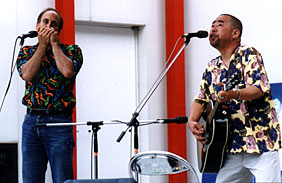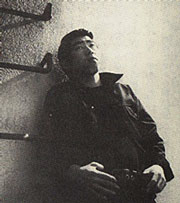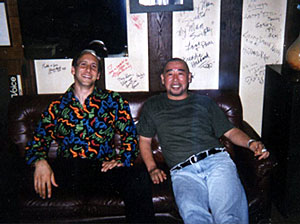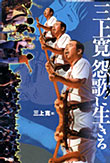[Home] [Elijah Wald Bio] [Robert Johnson] [Josh White] [Narcocorrido] [Dave Van Ronk] [Hitchhiking]
[African Guitar] [Books and writing] [My CD and other
album projects] [Joseph Spence DVD]
The luckiest break of my recent musical career was happening to open a show in Kyoto for Mikami Kan. Afterwards, we drank far too much sake, and despite the fact that his English is minimal and my Japanese nonexistent, we became friends. In July 2002 he invited me over to Japan to do a three-week tour together, one of the most interesting and rewarding trips of my life.
 Like other writers, I have always been baffled at how to describe Kan’s music. The best I can do is suggest that one imagine a Japanese student rebel in the late 1960s who was listening to the Beatles, Bob Dylan, and Neil Young, and decided he wanted to do something similar, but in a way that was entirely Japanese. But that leaves out his uncanny Ray Charles immitation, which led to a brief stint singing with a big band. And the avante-garde experimentation that has always driven both his lyrics and his music. And all the influence of writers, from Americans like Ginsburg and Bukowski to Japanese avante-gardists like Terayama, who was one of his mentors. And his unique guitar technique, usually played on a solid-body electric instrument without any other accompaniment. And his incredible vocal power, including screams that use overtones to get two or more notes at one time.
Like other writers, I have always been baffled at how to describe Kan’s music. The best I can do is suggest that one imagine a Japanese student rebel in the late 1960s who was listening to the Beatles, Bob Dylan, and Neil Young, and decided he wanted to do something similar, but in a way that was entirely Japanese. But that leaves out his uncanny Ray Charles immitation, which led to a brief stint singing with a big band. And the avante-garde experimentation that has always driven both his lyrics and his music. And all the influence of writers, from Americans like Ginsburg and Bukowski to Japanese avante-gardists like Terayama, who was one of his mentors. And his unique guitar technique, usually played on a solid-body electric instrument without any other accompaniment. And his incredible vocal power, including screams that use overtones to get two or more notes at one time.
Kan’s history as a performer reaches back to the 1970 student rebellion, Japan’s version of the international movement that had hit Paris and the US in 1968. Born into a family of squid fishermen in the tiny town of Kodomari on Japan’s north coast, he had moved to the regional center of Goshogawara, Aomori, for high school. He recalls that it was a complete culture shock to suddenly find himself in the bohemian, musical, student environment of a town that today seems small and regional, but then seemed like the most exciting place in the world. "When I came to Tokyo later, that was no shock," he says, laughing. "Goshogawara, that was a shock."
 Caught up in poetry and music, he released his first album in 1970, and became an instant youth star. Though "voluntarily withdrawn" be the record company due to political pressures, the album sold some 30,000 copies, and suddenly he was a spokesman for the new generation. It was a heady, amazing time, but only lasted a few short years. "Then all my fans, they cut their hair, they put on suits . . . I was all alone." Kan turned to writing and acting, eventually appearing in fifty movies and innumerable television shows. (His only performances available to international viewers are in "Merry Christmas Mr. Lawrence," maltreating David Bowie, and in the 1992 Japanese film "Topazu" [also known as "Tokyo Decadence"] by Ryu Murakami.)
Caught up in poetry and music, he released his first album in 1970, and became an instant youth star. Though "voluntarily withdrawn" be the record company due to political pressures, the album sold some 30,000 copies, and suddenly he was a spokesman for the new generation. It was a heady, amazing time, but only lasted a few short years. "Then all my fans, they cut their hair, they put on suits . . . I was all alone." Kan turned to writing and acting, eventually appearing in fifty movies and innumerable television shows. (His only performances available to international viewers are in "Merry Christmas Mr. Lawrence," maltreating David Bowie, and in the 1992 Japanese film "Topazu" [also known as "Tokyo Decadence"] by Ryu Murakami.)
By 1979, though, he had decided to devote himself to music once again. It was not an easy choice. His audience gone, he toured for several years in the bleakest conditions. "My electricity was shut off, my water was shut off. My first wife left, with our son." Still, he kept going, and gradually reemerged as a potent force in the Japanese musical underground. His current status is in some ways similar to that of Tom Waits, a unique voice that is unlike any other. Some call him a folksinger, some a rocker -- the wisest do not even try to classify him, but just listen.
Doors, in Tokyo. A rock club, where the bathrooms were labeled "Jim" and "Janis," and the soundman asked whether we wanted him to run the smoke machine.

Jomon No Kai, a biannual festival in Iwaki. The 40th festival featured Kan and a variety of his favorite musicians, from a traditional shimasen virtuoso to jazz, rock, folk, and free improvisatory players, as well as dancers and action painters.
Basie, in Ichinoseki. I got the flavor of this room right off, when the owner greeted me with the words, "You call me Swifty. Count Basie gave me this nickname." A sophisticated jazz room, the walls lined with tens of thousands of classic LPs.
Aoni Onsen, Kuroishi. A hot springs, way out in the mountains of Aomori, so traditional that the rooms have no electricity, and light is provided by kerosene lanterns. Kan and I played a brief evening show, unamplified, to an audience clad in yukatas and kneeling on tatami mats.
Sculpture studio/storefront, Hakodate, Hokkaido. Owned by a friend of Kan’s, a sculptor from the indigenous Ainu ethnic group, this was a cluttered store on a busy street. The owner set up a sound system, and we played to a dozen seated listeners and whoever happened to be walking by, then had a mass barbecue on the sidewalk.
Kaze no Kobo (Wind Factory), Eigeni, near Kyoto. Another artist’s studio, this time a cloth painter with a gorgeous 110-year-old house, built of wood and paper. Once again, we played unaccompanied to an audience sitting on the tatami floor, with the screens open behind us to show the lovely Japanese garden.

All in all, it was an amazing experience, and I would encourage anyone reading this to become better acquainted with Mikami Kan’s work. His records are available from the forcedexposure website, which also has commentary on each of them. Other sites of interest include a long interview with him by Alan Cummings, and an entertaining piece by Kelly Burnett. All are well worth checking out, but none come close to the power of one of Mikami Kan’s live shows -- it is worth a trip to Japan just to see him stomping, shouting, and moaning with aching soul, transporting audiences in a way that only a handful of world artists can ever hope to match.